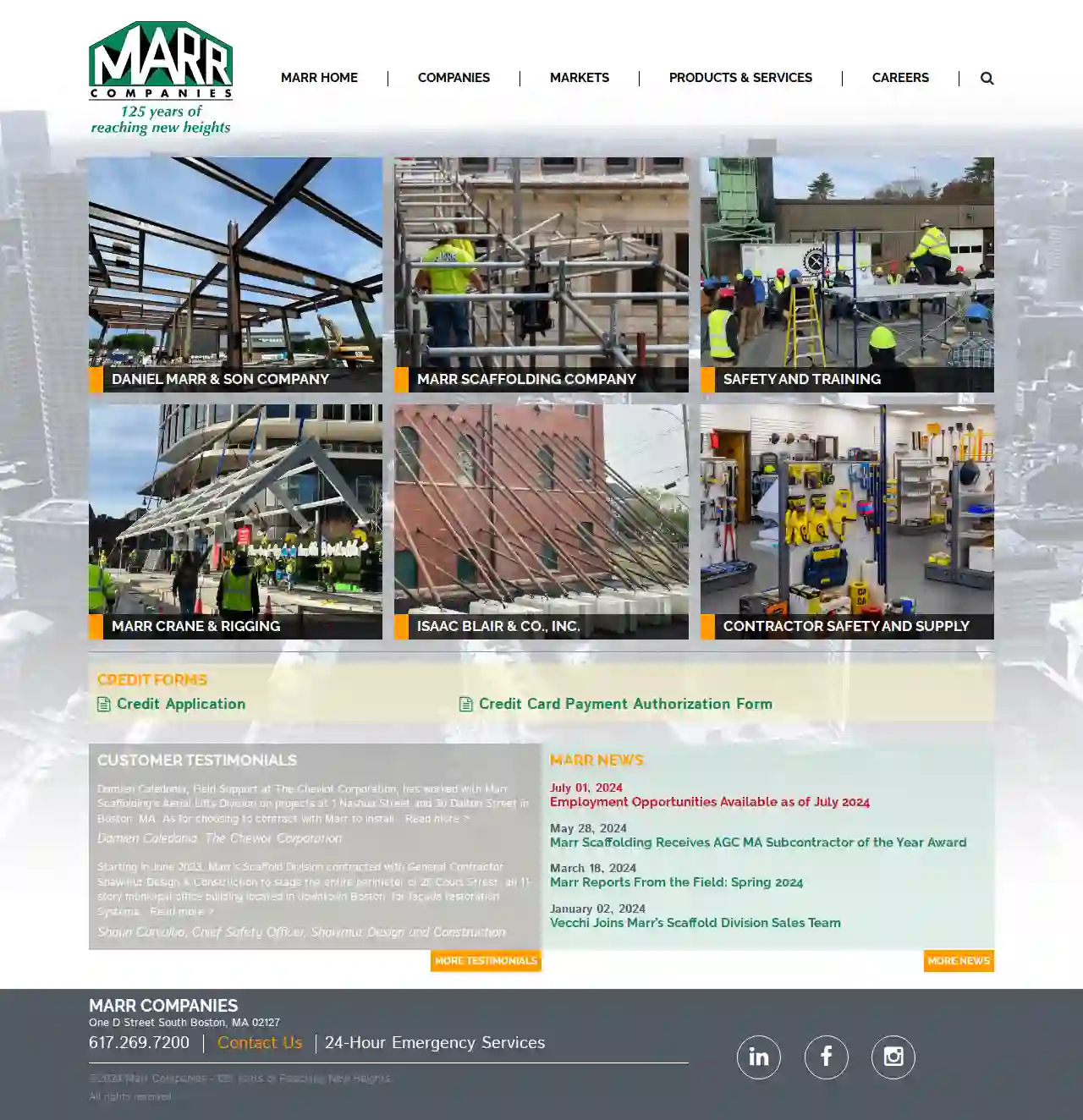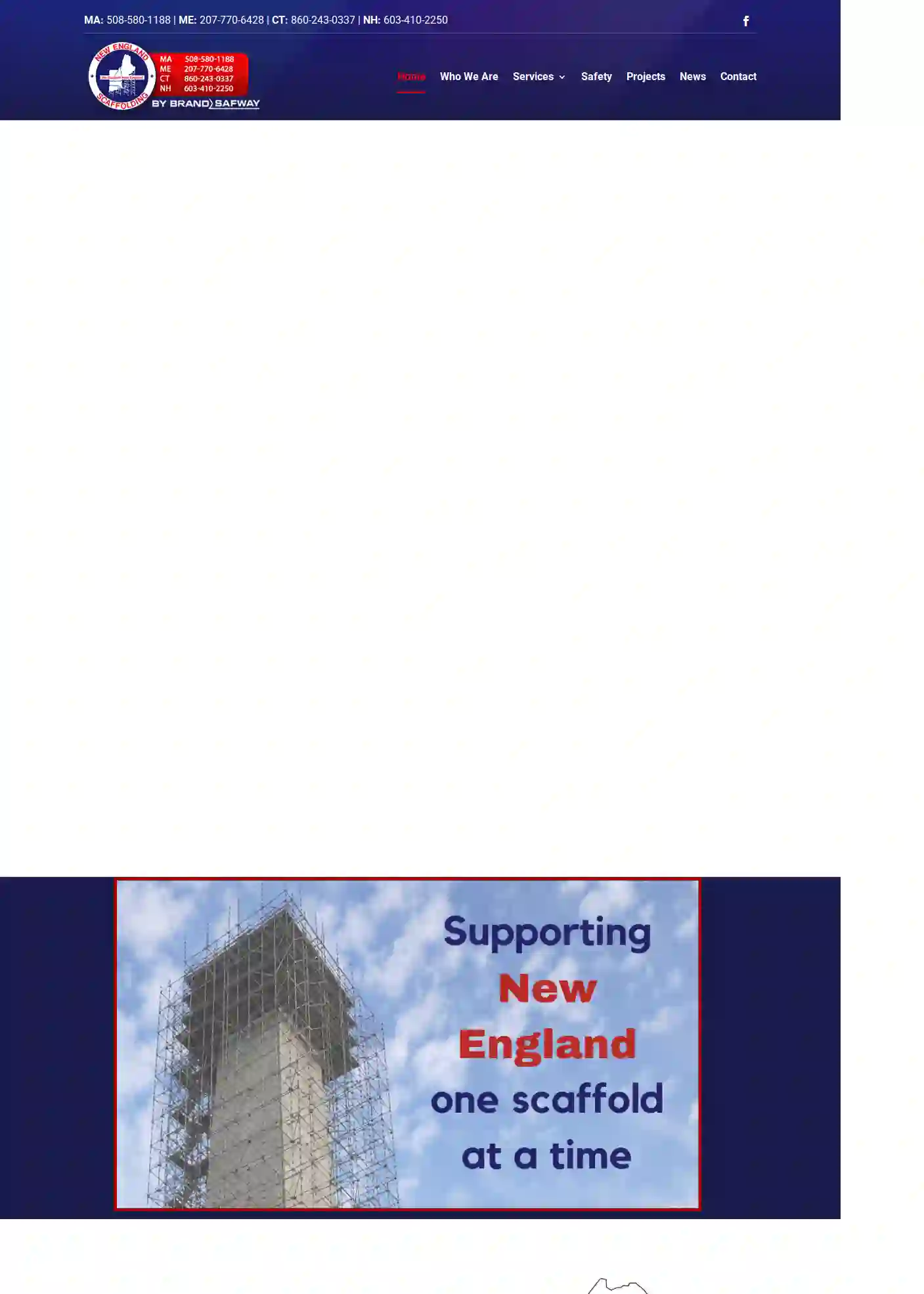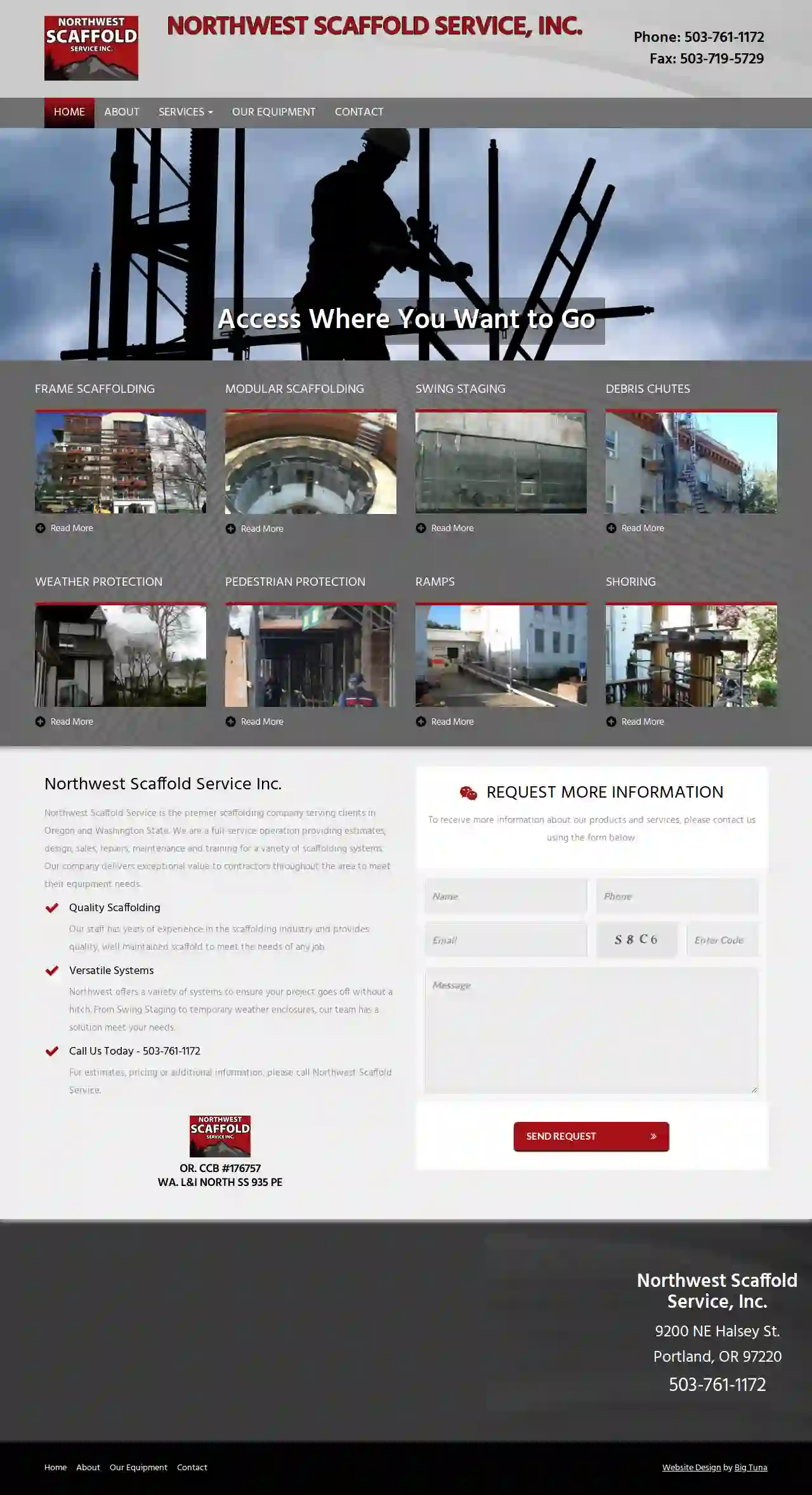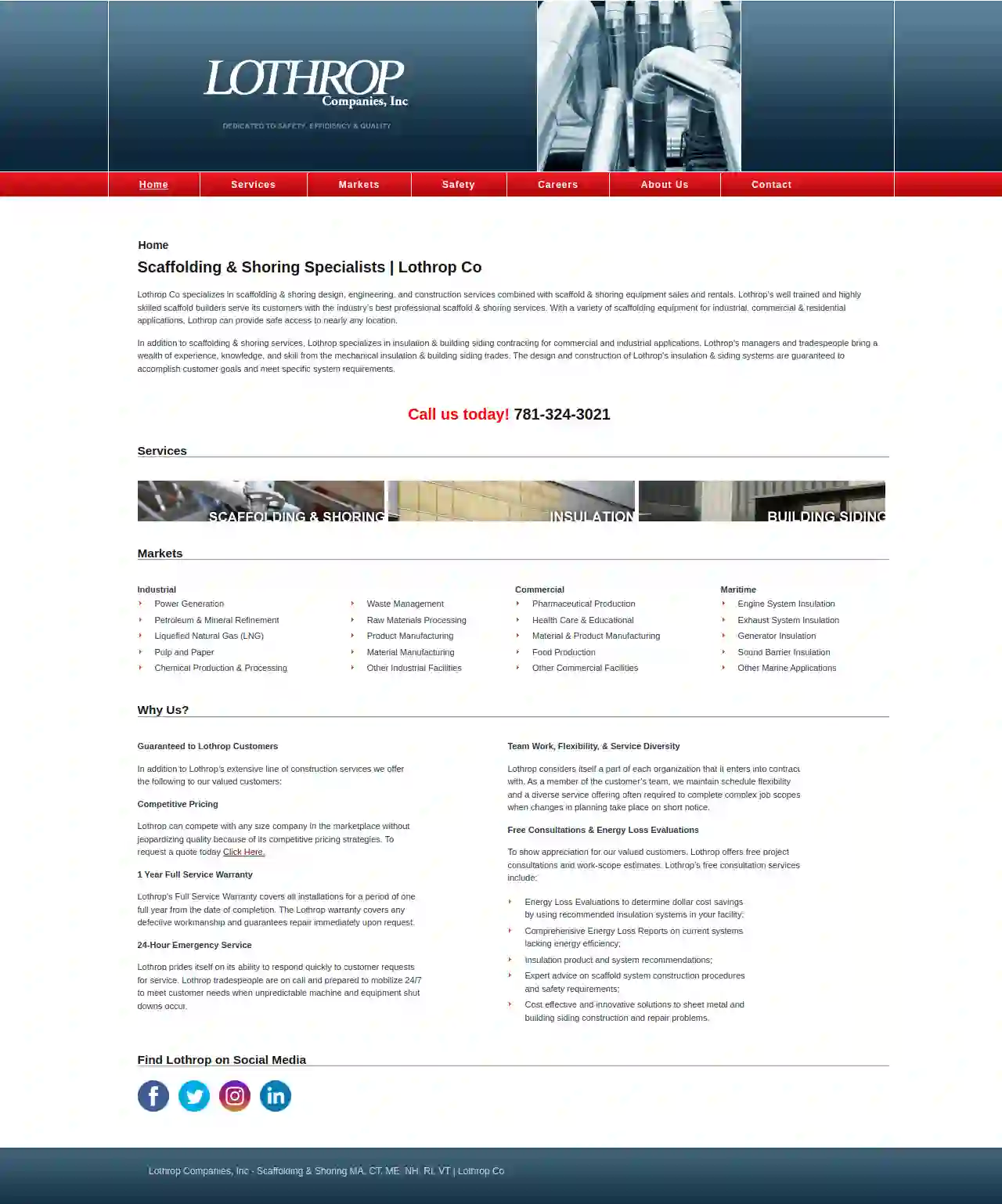Scaffolding Rental Hooksett
Top 10 Scaffolding Equipment Rental in Hooksett
Receive multiple Temporary Scaffolding quotes for your project today! Compare profiles, reviews, accreditations, portfolio, etc... and choose the best service.

Marr Scaffolding Company
4.421 reviewsBoston, MA, 1 D Street, 02127, USMarr Companies is a leading provider of safety and training solutions, with over 125 years of experience in the industry. Our mission is to provide top-notch services to our clients, ensuring their safety and well-being. We offer a wide range of services, including aerial lifts, aluma joists, angel's wings, bleachers, boom lifts, bracing, building remediation, calibrated jacking, chutes, column replacement, contractor's safety and supply warehouse, construction elevators, cranes, dryair, elevators, emergency services, enclosures, environmental work, erection and dismantling, fall protection products, grandstands, ground thaw, heat wagon, hi-lite, hoists, hydro mobile, ladders, lulls, mast-climbing work platforms, needle shoring, plank, post shores, precast erection, pre-construction planning, redi-fence, rigging, safety, safety products, scaffolding, scissor lifts, sectional scaffold, shore-x, shoring, sidewalk protection, specialty shoring, specialty rigging, steel erection, suspended scaffolds, systems scaffold, temporary heat, temporary seating, trucking, wall bracing, and warehousing. Our team of experts is dedicated to providing the highest level of service and support to our clients. We are fully accredited and insured, and we take pride in our work. We are committed to reaching new heights and providing the best possible solutions to our clients.
- Services
- Why Us?
- Accreditations
- Our Team
- Testimonials
- Gallery
Get Quote
New England Scaffolding
4.214 reviews412 R Washington St, Norwell, 02061, USNew England Scaffolding is a leading provider of scaffolding solutions for various industries. With offices in Massachusetts, Maine, Connecticut, and New Hampshire, we offer a range of services including scaffolding, shoring, suspended scaffolding, containment, temporary fencing, and debris chutes. Our team of experts will work with you to design a custom solution that meets your specific needs and ensures your project is completed safely and efficiently. With over 20 years of experience, we have established ourselves as a trusted partner for many clients. Contact us today to learn more about our services and how we can help you achieve your goals.
- Services
- Why Us?
- Gallery
Get Quote
Skywalker Management Corp.
Brooklyn, Brooklyn, NY, USAt Skywalker Management Corp., we're a leading provider of scaffolding installation and rental services in New York. With years of experience, our team of fully qualified and experienced scaffolders can handle any job, big or small. From domestic loft conversions to large-scale building projects, we offer safe, secure, and professionally built scaffolding solutions. Whether you need scaffolding for construction, theatre, or events, we're here to help. Our friendly team is always available to discuss your requirements and provide a quote. Contact us today to learn more about our services and how we can help you achieve your goals.
- Services
- Why Us?
- Gallery
Get Quote
Lynn Ladder & Scaffolding Co., Inc.
3.813 reviewsLynn, MA, USLynn Ladder was founded in 1946 by Bernie Kline. Bernie’s mission was to provide Ladders and Scaffolding to contractors in the New England area. Today, the third generation of Kline’s continue to pursue that goal across the Eastern United States. Service and quality are paramount in this endeavor. At each of the Lyn-Lad companies, we strive to provide each of our customers with reasonably priced, high quality products in a timely manner.
- Services
- Why Us?
- Accreditations
- Gallery
Get Quote
Northwest Scaffold Service, Inc.
4.741 reviews9200 NE Halsey St., Portland, 97220, USNorthwest Scaffold Service is the premier scaffolding company serving clients in Oregon and Washington State. We are a full-service operation providing estimates, design, sales, repairs, maintenance and training for a variety of scaffolding systems. Our company delivers exceptional value to contractors throughout the area to meet their equipment needs. Quality Scaffolding Our staff has years of experience in the scaffolding industry and provides quality, well maintained scaffold to meet the needs of any job. Versatile Systems Northwest offers a variety of systems to ensure your project goes off without a hitch. From Swing Staging to temporary weather enclosures, our team has a solution meet your needs. Call Us Today - 503-761-1172 For estimates, pricing or additional information, please call Northwest Scaffold Service. Request More Information To receive more information about our products and services, please contact us using the form below. Northwest Scaffold Service, Inc. 9200 NE Halsey St. Portland, OR 97220 503-761-1172
- Services
- Why Us?
- Accreditations
- Our Team
- Testimonials
- Gallery
Get Quote
Skyway Canada LTD
170 Claireville Drive, Toronto, M9W 5Y3, USAt Skyway Canada, we pride ourselves on being a leading provider of industrial and commercial services. With a rich history and a strong mission to deliver exceptional results, we have established ourselves as a trusted partner for businesses across Canada and the United States. Our team of experienced professionals is dedicated to providing top-notch services, including industrial scaffolding, insulation, painting and protective coating, fireproofing, abatement, rope access, and more. We also offer commercial services such as access scaffolding, swing stage, shoring, fencing, hoardings, and debris chutes. At Skyway Canada, we are committed to safety and quality. We are proud members of various industry associations and have received numerous accreditations, including Avetta safe auditing and Complyworks. Our team is dedicated to providing exceptional service and ensuring that our clients are completely satisfied with our work.
- Services
- Why Us?
- Accreditations
- Gallery
Get Quote
Commonwealth Scaffold
59 reviews88 Eastern Ave, Malden, 02148, USWe Build Safe, So You Can Build Safer Commonwealth Scaffold, LLC serves Boston and the New England area market and is committed to providing our customers with the highest quality scaffolding products and service. Our History A union company with a focus on safety and bringing innovative solutions to complex jobsites. Commonwealth Scaffold, founded in 2007 by Luke McKinnon and Peter Volpe, is a Boston based scaffolding contractor servicing the New England area with the highest quality scaffolding planning and erection. Our main objective is to deliver safe and innovative solutions to your difficult builds. We use experience, open communications, a safety oriented approach and innovative design to accomplish our clients’ goals and needs. Our extensive portfolio of specialized services includes: scaffolding, coatings, insulation, refractory, formwork and shoring, specialty mechanical services, trash chutes and other related crafts. Our Approach Experience A team with unrivaled experience and leading edge training. Communication Managment that listens to our clients unique challenges and goals. Safety A focus on safety to keep your jobsite injury-free and on schedule. Innovation Solution oriented approach to complex builds and jobsites.
- Services
- Why Us?
- Our Team
- Gallery
Get Quote
Scaffolding Towers of America
414 reviews330 Roycefield Rd., Building J, Hillsborough, 08844, USScaffolding Towers of America, Inc. is New Jersey's leading provider of scaffolding and access equipment. With over 50 years of experience, we offer a wide range of products and services to meet the needs of our clients, from small contractors to large corporations. Our commitment to quality, safety, and customer service has made us the trusted partner for scaffolding solutions throughout the Tri-State area. We carry a comprehensive inventory of Bil-Jax frame scaffolding and components, as well as system scaffolding from Layher and A-1 Scaffolding. Our IN-STOCK selection of scaffolding equipment is the largest in New Jersey, and our range of OSHA compliant products includes scaffold frames, rolling towers, stair towers, plank, aluminum platforms, baker scaffolding, leveling jacks, casters, braces, climbing ladders, hoist arms, guard rails, swivel clamps, straight clamps, and well wheels. We offer both new and used scaffold for sale. If you know your piece count, we can quickly provide a quote for you. If you aren't sure, simply call us with the required dimensions and we can get you an estimate. Most scaffold orders are available for pick up the same day. We can also deliver your scaffold order for an additional charge. Advance notice is required for scaffold delivery. Scaffold installation is also available. In addition to our scaffolding products, we also carry a variety of Werner products designed to provide access. These include various heights of stepladders, extension ladders, platform ladders, podium ladders, aluminum and steel pump jacks, and 20" wide 2-man stages (picks). All products are IN STOCK and available for pick up today. Delivery is also available. Our team of experienced professionals is dedicated to providing our clients with the highest quality scaffolding solutions. We are committed to safety, reliability, and customer satisfaction. Contact us today to learn more about our products and services.
- Services
- Why Us?
- Gallery
Get Quote
R&R Scaffolding, Ltd.
4.69 reviews333 SE 2nd Ave, Miami, 33131, USR&R Companies have been pioneers and innovators in the suspended scaffold industry for nearly four decades. We deliver services and products ranging from the simplest solutions to the most complex systems. Our primary markets include commercial, industrial, institutional, and residential sectors. Our diverse portfolio of brands and extensive capabilities have transformed us into the multifaceted company we are today.
- Services
- Why Us?
- Accreditations
- Gallery
Get Quote
Scaffolding & Shoring Specialists | Lothrop Co
4.49 reviewsMalden, MA, 30 Winter Street, 02148-1426, USLothrop Companies, Inc. specializes in scaffolding & shoring design, engineering, and construction services combined with scaffold & shoring equipment sales and rentals. With a variety of scaffolding equipment for industrial, commercial & residential applications, Lothrop can provide safe access to nearly any location. In addition to scaffolding & shoring services, Lothrop specializes in insulation & building siding contracting for commercial and industrial applications. Lothrop's managers and tradespeople bring a wealth of experience, knowledge, and skill from the mechanical insulation & building siding trades. The design and construction of Lothrop's insulation & siding systems are guaranteed to accomplish customer goals and meet specific system requirements.
- Services
- Why Us?
- Accreditations
- Our Team
- Testimonials
- Gallery
Get Quote
Over 2,353+ Scaffolding Businesses onboarded
Our scaffolding contractors operate in Hooksett & surroundings!
ScaffoldingHQ has curated and vetted Top Scaffolding Businesses in Hooksett. Find the most trustworthy pro today.
Frequently Asked Questions About Scaffolding Rental
- Clean and Dry: Clean the scaffolding components thoroughly and allow them to dry completely before storage.
- Rust Prevention: Apply a rust inhibitor to metal components, especially if they will be stored outdoors.
- Organized and Labeled: Store components in an organized manner, labeling them clearly for easy identification.
- Covered Storage: Store scaffolding in a dry, covered area, protected from the elements.
- Off the Ground: Elevate the scaffolding components off the ground using pallets or racks to prevent moisture damage.
- Base Plates and Adjusters: Use adjustable base plates to level the scaffolding legs on uneven surfaces.
- Ground Preparation: Level the ground as much as possible before erection.
- Bracing and Support: Additional bracing and support may be necessary to compensate for uneven ground conditions.
- Professional Assessment: A qualified scaffolding erector should assess the ground and determine the appropriate measures for safe erection.
- Daily: For short-term tasks or smaller projects.
- Weekly: A common option for projects lasting a few days to a week.
- Monthly: Suitable for larger or longer-term projects.
- Custom Duration: Some companies may offer custom rental periods to fit your specific timeframe.
- Underestimating Scaffolding Needs: Accurately assess the required scaffolding size and type.
- Not Comparing Quotes: Get quotes from multiple rental companies to find the best deal.
- Ignoring Safety: Prioritize safety by hiring qualified erectors and ensuring workers follow safety protocols.
- Overlooking Permits: Obtain any necessary permits before erecting scaffolding.
- Not Inspecting the Scaffolding: Carefully inspect the scaffolding upon delivery and before each use.
- Modifying Scaffolding without Authorization: Never alter the scaffolding without consulting the rental company or an engineer.
What are some tips for storing scaffolding?
Can I use scaffolding on uneven ground?
How long can you rent scaffolding for?
What are some common mistakes to avoid when renting scaffolding?
What are some tips for storing scaffolding?
- Clean and Dry: Clean the scaffolding components thoroughly and allow them to dry completely before storage.
- Rust Prevention: Apply a rust inhibitor to metal components, especially if they will be stored outdoors.
- Organized and Labeled: Store components in an organized manner, labeling them clearly for easy identification.
- Covered Storage: Store scaffolding in a dry, covered area, protected from the elements.
- Off the Ground: Elevate the scaffolding components off the ground using pallets or racks to prevent moisture damage.
Can I use scaffolding on uneven ground?
- Base Plates and Adjusters: Use adjustable base plates to level the scaffolding legs on uneven surfaces.
- Ground Preparation: Level the ground as much as possible before erection.
- Bracing and Support: Additional bracing and support may be necessary to compensate for uneven ground conditions.
- Professional Assessment: A qualified scaffolding erector should assess the ground and determine the appropriate measures for safe erection.
How long can you rent scaffolding for?
- Daily: For short-term tasks or smaller projects.
- Weekly: A common option for projects lasting a few days to a week.
- Monthly: Suitable for larger or longer-term projects.
- Custom Duration: Some companies may offer custom rental periods to fit your specific timeframe.
What are some common mistakes to avoid when renting scaffolding?
- Underestimating Scaffolding Needs: Accurately assess the required scaffolding size and type.
- Not Comparing Quotes: Get quotes from multiple rental companies to find the best deal.
- Ignoring Safety: Prioritize safety by hiring qualified erectors and ensuring workers follow safety protocols.
- Overlooking Permits: Obtain any necessary permits before erecting scaffolding.
- Not Inspecting the Scaffolding: Carefully inspect the scaffolding upon delivery and before each use.
- Modifying Scaffolding without Authorization: Never alter the scaffolding without consulting the rental company or an engineer.